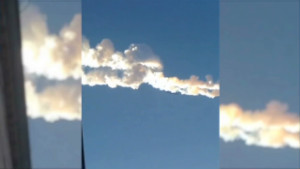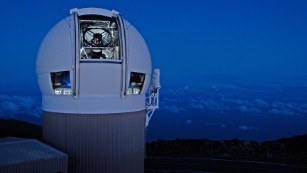Russia wants to modify Cold War missiles to destroy asteroids
Russia plans to modify some of its intercontinental ballistic missiles to destroy asteroids before they hit Earth, according to a top Russian rocket researcher.
Sabit Saitgarayev of Russia's Makeyev Rocket Design Bureau revealed the effort during an interview last week with the government-owned TASS news agency.
The United States is also working on ways to prevent asteroids from hitting Earth, but is taking a very different approach. Instead of blowing up the space rocks, NASA plans to shove them away from the planet.
READ: How NASA will save the earth from giant asteroids
It is the latest frontier in efforts by both countries to tackle a threat to the planet that dates at least from the extinction of the dinosaurs.
The Russian missiles would be used to target smaller asteroids of 20 meters to 50 meters in diameter.
These smaller asteroids can cause significant damage and can sometimes be detected only by observatories a few hours in advance of their reaching Earth.
Sometimes, they aren't detected at all. In 2013, a 20-meter-wide meteor exploded in the sky over Chelyabinsk, Russia, with the estimated force of 300,000 tons of TNT or more, shattering glass in buildings and leaving more than 1,000 people injured.

Russian meteor was like 'a rocket bomb' 02:34
READ: Russia starts cleanup after meteor strike
None of Earth's space agencies saw it coming.
"Unfortunately, we only know about roughly 1% of those asteroids that get down to the 30-meter size, so there's a tremendous amount out there that we have yet to discover," noted Jason Kessler, the director of NASA's effort to find all asteroid threats to human populations.
Larger asteroids can cause much more damage but can be detected early by space observatories using advanced telescopes and infrared technology.
Kessler said that NASA calculates it has "discovered about 95% of the one kilometer or larger asteroids," roughly the size of the one thought to have wiped out the dinosaurs upon impact.
READ: How to land a space probe on a comet
Unlike rockets that deliver satellites to orbit or ferry people and supplies to the space station, intercontinental ballistic missiles, or ICBMs, are designed to be used during a war and can launch at a moment's notice.
The prospect of Russia modifying nuclear missiles for outer space is likely to cause alarm within the U.S. military. The office of the Director of National Intelligence has already expressed concern about Russian military activities in space.
Its 2016 threat assessment says that Russia continues "to pursue weapons systems capable of destroying satellites on orbit." The assessment notes that "the Russian Duma officially recommended in 2013 that Russia resume research and development of an airborne antisatellite missile to 'be able to intercept absolutely everything that flies from space.'"
Russia has large numbers of nuclear-armed ICBMs in its strategic arsenal that could potentially be converted. It is unclear if the Russian plan would use a conventional explosive in the repurposed missile, but its targeting system is likely to require significant modifications.
Saitgarayev acknowledged in the TASS interview that the modifications would take time and cost millions of dollars but said they are aiming to test the new missile against the larger 355-yard asteroid Apophis that is due to pass close to Earth in 2036.
Astrophysics professor Henry Melosh of Purdue University cautioned against the nuclear option, calling the effort "misguided and potentially dangerous."
Melosh worked on NASA's Deep Impact mission. The spacecraft dropped an impactor onto a comet in 2005.
Melosh downplayed the threat posed by smaller asteroids and told CNN, "There are other, safer ways to deflect asteroids with long lead times."
He pointed to kinetic deflection, which would fire a rocket into the asteroid to knock it off course, or gravity tractors, which uses a spaceships gravity field to nudge the asteroid off its trajectory.
"For now, the best thing we can do is to identify potentially hazardous asteroids in space and project their time and location of impact," he said.
READ: Life on Mars? Depends how you see these photos
According to Melosh, there are also ongoing efforts at the two U.S. nuclear weapons research centers, Los Alamos National Laboratory and Lawrence Livermore National Laboratory, to investigate the possibility of using nuclear weapons against larger asteroids with long warning times.
Paul Miller, associate division leader of the Design Physics Division at Lawrence Livermore, told CNN that the institution was "supporting NASA by modeling deflection techniques, including kinetic impactors or nuclear explosions."

NASA Planetary Defense Office set up to save Earth 01:44
Miller added, "We know of no interest in the U.S. in repurposing ICBMs" and questioned their utility in preventing asteroid impacts.
Deflection intercepts need to occur months, years or decades in advance, and the associated intercept locations are typically very far from Earth, he said.
And he assessed that other developments would be more effective.
As asteroid detection surveys improve, he said, "they should provide decades of warning. In that case, a ready-to-launch capability is unnecessary."
NASA wouldn't address the possibility of using nuclear weapons to destroy asteroids and would not comment on the viability of the Russian undertaking, but is emphasizing its nonnuclear approach.
One way NASA plans to protect Earth from asteroids is to push the asteroids away from the planet. The space agency is developing an Asteroid Redirect Mission -- the "first-ever robotic mission to visit a large near-Earth asteroid" and "redirect it into a stable orbit around the moon."
This mission is primarily intended to study asteroids and is projected to be ready for deployment in the 2020s.
Ben Reed, who heads up the team developing the Redirect Mission, told CNN in June that the robotic lander could use its thrusters to nudge an asteroid off a collision course with Earth. Or alternatively, he said, the lander could use its own gravitational pull to make slight changes to an asteroid's trajectory if it were deemed a danger.
"We have the technologies to mitigate any potential threats," Reed said.
NASA also announced in January that it has formalized its program for detecting and tracking asteroids that could threaten Earth. The new program is called the Planetary Defense Coordination Office. NASA said the office will take a leading role in coordinating a response to any potential asteroid impacts.
READ: How asteroid can help us reach Mars
In a press release announcing the office, the agency said its "long-term planetary defense goals include developing technology and techniques for deflecting or redirecting objects that are determined to be on an impact course with Earth."
News Courtesy: www.cnn.com











